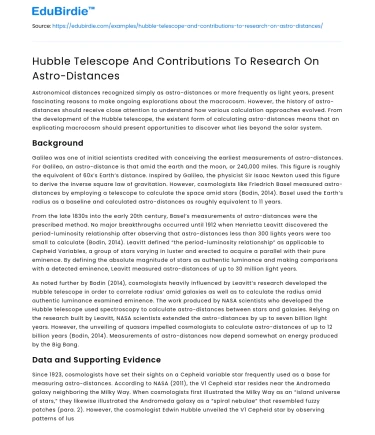Astronomical distances recognized simply as astro-distances or more frequently as light years, present fascinating reasons to make ongoing explorations about the macrocosm. However, the history of astro-distances should receive close attention to understand how various calculation approaches evolved. From the development of the Hubble telescope, the existent form of calculating astro-distances means that an explicating macrocosm should present opportunities to discover what lies beyond the solar system.
Background
Galileo was one of initial scientists credited with conceiving the earliest measurements of astro-distances. For Galileo, an astro-distance is that amid the earth and the moon, or 240,000 miles. This figure is roughly the equivalent of 60x’s Earth’s distance. Inspired by Galileo, the physicist Sir Isaac Newton used this figure to derive the inverse square law of gravitation. However, cosmologists like Friedrich Basel measured astro-distances by employing a telescope to calculate the space amid stars (Bodin, 2014). Basel used the Earth’s radius as a baseline and calculated astro-distances as roughly equivalent to 11 years.
Save your time!
We can take care of your essay
- Proper editing and formatting
- Free revision, title page, and bibliography
- Flexible prices and money-back guarantee
From the late 1830s into the early 20th century, Basel’s measurements of astro-distances were the prescribed method. No major breakthroughs occurred until 1912 when Henrietta Leavitt discovered the period-luminosity relationship after observing that astro-distances less than 300 lights years were too small to calculate (Bodin, 2014). Leavitt defined “the period-luminosity relationship” as applicable to Cepheid Variables, a group of stars varying in luster and erected to acquire a parallel with their pure eminence. By defining the absolute magnitude of stars as authentic luminance and making comparisons with a detected eminence, Leavitt measured astro-distances of up to 30 million light years.
As noted further by Bodin (2014), cosmologists heavily influenced by Leavitt’s research developed the Hubble telescope in order to correlate radius’ amid galaxies as well as to calculate the radius amid authentic luminance examined eminence. The work produced by NASA scientists who developed the Hubble telescope used spectroscopy to calculate astro-distances between stars and galaxies. Relying on the research built by Leavitt, NASA scientists extended the astro-distances by up to seven billion light years. However, the unveiling of quasars impelled cosmologists to calculate astro-distances of up to 12 billion years (Bodin, 2014). Measurements of astro-distances now depend somewhat on energy produced by the Big Bang.
Data and Supporting Evidence
Since 1923, cosmologists have set their sights on a Cepheid variable star frequently used as a base for measuring astro-distances. According to NASA (2011), the V1 Cepheid star resides near the Andromeda galaxy neighboring the Milky Way. When cosmologists first illustrated the Milky Way as an “island universe of stars,” they likewise illustrated the Andromeda galaxy as a “spiral nebulae” that resembled fuzzy patches (para. 2). However, the cosmologist Edwin Hubble unveiled the V1 Cepheid star by observing patterns of luster and paling. For Hubble, the V1 Cepheid star indicated that astro-distances could extend further than what Leavitt measured. Since the original use of the Hubble telescope in the late 1980s, cosmologists have used the V1 Cepheid star as a reliable basis for reliably calculating astro-distances between spiral nebulae beyond the Andromeda galaxy (NASA, 2011, para. 20). Hubble unveiled the V1 Cepheid star by plotting its light curve and eliminating the possibility that any observations of true luminosity resembled an exploding star (Bodin, 2014; NASA, 2011). Despite how cosmologists formed rough appraisals of the astro-distances to exploding stars, Hubble unveiled the V1 Cepheid star by drawing from rough appraisals and calculating true luminance.
Results
The Hubble telescope grants cosmologists to calculate astro-distances of up to 10,000 light years from Earth. Cosmologists use the parallax technique as a reliable method for measuring astro-distances (NASA, 2014, para. 4). The parallax technique works for cosmologists involved in calculating astro-distances to stars only a few hundred light years from Earth. However, stars further away have smaller angles and also appear to move (para. 6). Despite these difficulties, astronomers aim to expand calculations of astro-distances by refining estimates of dark matter present in the explicating universe. In so doing, cosmologists may apply the parallax technique to measure astro-distances between the Earth and stars far beyond the V1 Cepheid (NASA, 2011; NASA, 2014). Yet, quantification of the broadening macrocosm will require that cosmologists make indirect observations of dark energy and dark matter by relying on a lack of true luminosity (Bondi, 2014). These measurements could also provide some evidence of undiscovered planets in an ever-expanding universe.
Discussion
The scientific advancements made by Hubble have significance based on strongly they shaped the course of astronomy. In providing evidence that the macrocosm is explicating, Hubble caused cosmologists to calculate astro-distances beyond the Milky Way and Andromeda galaxies (NASA, 2011, NASA, 2014). Still in use, the Hubble telescope can take precise photographs that represent the radius amid Earth’s orbit and stars as far as 10,000 light years away. By relying on the parallax technique, astronomers now acquire the tools to resolve whether astro-distances amid the Earth and dark matter in a broadening universe are probable to calculate. Considering how the universe explicates, more sophisticated techniques are necessary to ensure the accuracy of astro-distances.
Conclusion
As a result of evolving discoveries, astro-distances remain a fascinating yet complex feature of astronomy. While astronomers rely on sophisticated techniques to calculate the radius amid the Earth and stars, the future of calculating astro-distances depends on whether agencies like NASA, have sufficient resources to make even more fascinating discoveries. Considering how an bolstering macrocosm contains plenty of dark matter and energy, advanced monumental analyses could propmpt some alarming results in the future.






 Stuck on your essay?
Stuck on your essay?

